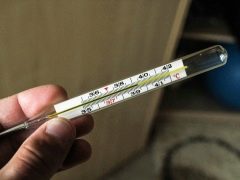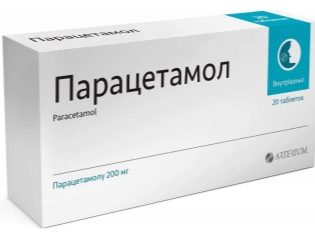What to do when the temperature in pregnant women in the first trimester?
Temperature rise in first trimester of pregnancy The future mother cannot help but be intimidated, because the first third of the baby’s term is considered the most dangerous, even critical for the child - during this period, the baby’s organs and systems are being formed, and any negative factor from outside and outside can disrupt these subtle processes.
Before we talk about the actions of a woman when a fever is detected, it is important to understand what causes it is caused.
Why does the temperature rise?
The processes that take place in the female body after conception took place are multifaceted and complex. And if for a healthy adult a temperature is considered to be normal within 36.2-36.9 degrees, for a perfectly healthy pregnant woman, the temperature option may be higher than 37.0 degrees. This is especially true in the initial periods.
In the first trimester, the hormone progesterone “fills in” all the processes; it is its high concentrations that soften the uterine muscles and prevent the onset of another menstruation. And it is precisely progesterone that is able to cause in the first weeks of the gestation period no one understood, completely inexplicable surges in body temperature.
Physiological temperature rise always takes place within subfebrile values - from 37.0 to 37.8 degrees. This temperature usually rises in the afternoon, some - only in the evenings. There are no other painful symptoms. A woman can experience a slight chill or feel that she is “throwing” from heat to cold and vice versa, when her temperature rises to this mark, and her cheeks and ears can burn. In the mornings, there is usually no trace of the increased evening temperature — the woman feels completely healthy.
With such a temperature, you do not need to consult a doctor, there is no need for treatment either.
The thermometer stops rising above 37.0 degrees after the pregnant woman's body fully adapts to the new hormonal background, usually it happens in the first 6-8 weeks, less often an episodic temperature rise persists until the end of the first trimester - up to 12-13 weeks of pregnancy.
On this, the natural and harmless causes of elevated temperature are exhausted, and less rosy situations begin. Progesterone suppresses female immunity, it is necessary in order to ensure the preservation of pregnancy, because aggressive immune cells can destroy the embryo, defining in it 50% of foreign genetic material (paternal genes). With a decrease in immunity, a woman becomes more vulnerable in the face of viruses, bacteria, fungi. Therefore, the appearance of high temperature in the first trimester is often associated with infectious diseases.
A distinctive feature of this temperature will be its values - with the flu the thermometer rises above 39.0 degrees, with ARVI - above 38.0 degrees.
Other symptoms of the disease will definitely be present:
- cough;
- sore throat;
- increased flow of nasal mucus, congestion;
- headaches and muscle aches;
- photosensitivity;
- feeling of pressure on the eyeballs.
With a high temperature, infectious diseases that are dangerous for a pregnant woman and especially for a baby: measles, chicken pox, rubella.
If high fever is combined with vomiting and intestinal dysfunction, an intestinal infection can be suspected.
Violation of urination, pain, frequent visits to the toilet for "little need", change in color and transparency of urine on the background of high temperature can be signs of normal or gestational pyelonephritis. In rare cases, an increase in temperature (to subfebrile values) accompanies allergic reactions.
In any case, with the exception of the physiological wave-like rise in temperature due to progesterone, a woman should consult a doctor. It is best to call a specialist at home, because no one has yet refuted the possibility of a contagious infection. The physician who should be invited into the home should be a general practitioner. It is unreasonable to address this issue with the gynecologist leading your pregnancy. Each medical professional has his own sphere of competence, and it would be better if it was the therapist who examined you.
Is it dangerous?
Hyperthermia in the first trimester of pregnancy is very dangerous. It can impair blood circulation between the mother and the embryo, cause serious disturbances in the work of the chorion or the young placenta, which comes to replace it by the end of the first trimester. But the main danger lies not only in the temperature itself, but in the reason that caused its rise.
During the period of organogenesis, which occurs during the first three months, the effect of viruses on the children's organism can lead to disastrous consequences.. The baby is still poorly protected by a young placenta or is not protected at all, and therefore all the viruses that penetrate the mother’s systemic circulation will go to the embryo.
Viral effects are embedded in the cell of the human body. The cell begins to work not according to the program laid down in it, but for the needs of the virus, and then simply dies. If this happens with the cells of the embryo, of which its internal organs and tissues are now laid, this can lead to the most diverse developmental defects, sometimes incompatible with life and further intrauterine development. No less dangerous for the forming fetus and bacteria with fungi.
With a long-lasting high temperature, the processes of protein synthesis begin to be disrupted, which adversely affects the processes of placentation - the formation of the “baby place” proceeds with violations, which can also lead to the death of the fetus or to the fact that the placenta cannot meet all the needs of the child in protection, nutrition, provision of oxygen, which is fraught with hypoxia, miscarriage, developmental delay, premature birth.
It is impossible to estimate the effects of temperature in advance. Much depends on the exact duration of pregnancy.. So, if the disease happened to a woman at 3-5 weeks of pregnancy, the heart of the baby may suffer, the nervous system, there may be defects when laying the gonads. Infectious attacks and hyperthermia after 7 weeks increase the likelihood of mental retardation and CNS defects, because at this time there is a differentiation of the brain regions of the fetus.
The consequence of prolonged high fever is viral or severe bacterial systemic lesion may be microcephaly (decrease in fetal brain volume), muscular hypotonia, defects of facial structures, impaired development of limbs from finger fusion (syndactyly) until they are completely absent.
It is very important to understand that a virus is a virus.. The rubella pathogen is very aggressive, it quickly penetrates the bloodstream and ruthlessly disfigures the child, while most ARVI pathogens (respiratory infections, commonly referred to as the common cold) do not possess such aggressive action. That is why after postponing rubella or toxoplasmosis at an early date, doctors recommend abortion, and after ARVI, such recommendations are usually not voiced.
How to reduce?
It is important to understand that temperature in pregnant women to 38.0 degrees does not need to be reduced at all. She - a protective mechanism that activates the body of the future mother in order to quickly deal with the pathogen. But if the body temperature is above this value, you should consult a doctor. Treatment will be prescribed depending on the symptom of which ailment is fever.
Aspirin is contraindicated to reduce the temperature of pregnant women.. It is permissible to use only drugs with paracetamol. You should not choose the form of soluble powders and syrups with a pronounced fruity aroma - they have a lot of dyes and preservatives.
More benefits will be from the most ordinary pills "Paracetamol".
A pregnant woman should call an ambulance if the temperature exceeds 39.0 degrees and is not amenable to drug exposure.
Regardless of what the treatment of a particular disease will be, the following helpful tips will help a woman with a temperature:
- in case of heat, one should not wrap oneself up in warm clothes; on the contrary, one should lighten the uniform of the clothes as much as possible, cover with a light sheet;
- a woman is shown abundant warm drink and bed rest;
- the room must be well ventilated, the air in it must be sufficiently humidified;
- inhalation, rubbing with alcohol, cold water, and badger fat are not recommended at the temperature, you should not wear wool socks and soar legs.
From folk remedies to reduce the temperature worth noting the effect of green tea with currants. But the grass is better not to brew, because many very useful medicinal plants have an aborting effect.
What to do when the temperature in the first trimester, see the following video.


















